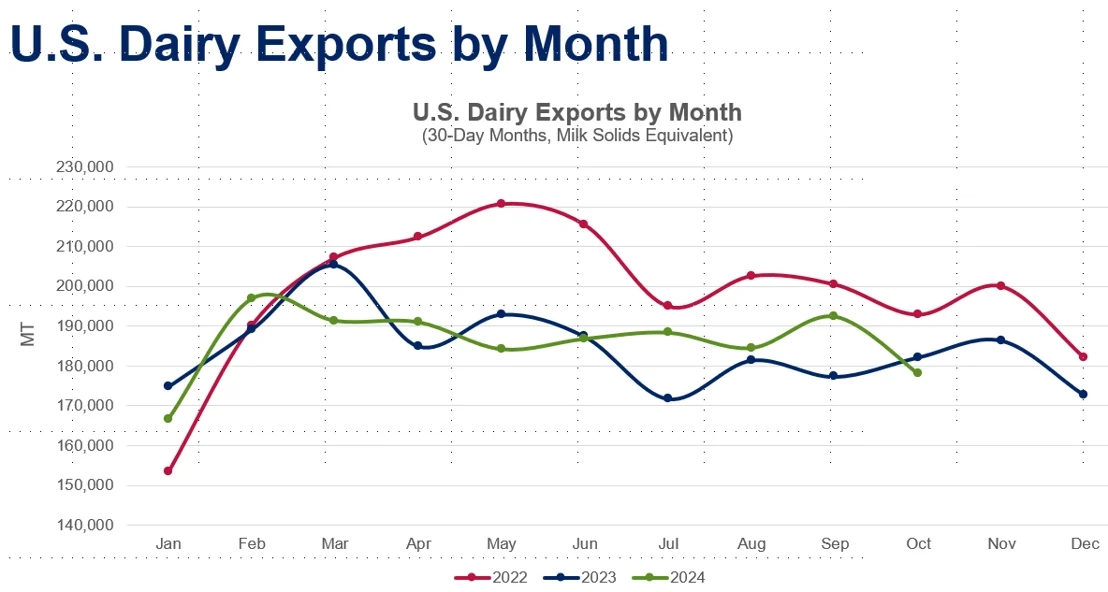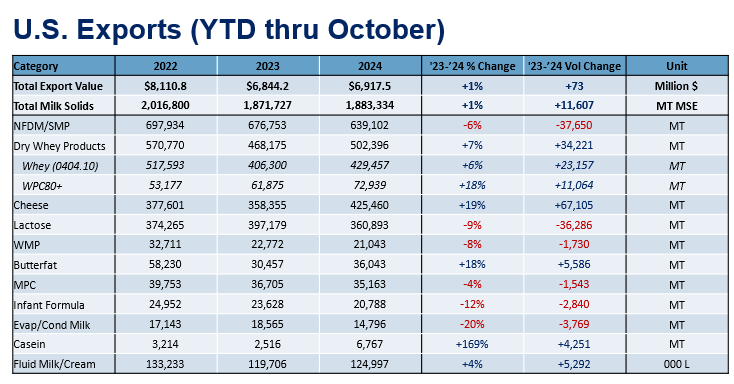U.S. Dairy Exports Drop 2% in October Amid Challenges in Whey and Milk Powder Markets

Despite the monthly decline, year-to-date (YTD) MSE volumes were still up 0.6% through October. The export value, however, told a different story, rising 11% YOY to $695.7 million in October, thanks to elevated commodity prices and strong sales of premium products like cheese and high-protein whey (WPC80+). This marked a notable recovery after a 5% decline in export value during the first half of 2024. Over the July-October period, export values grew by 9%, bringing the YTD total to $6.92 billion, a 1% increase over the same period in 2023.
Cheese Exports Shine
U.S. cheese exports continued their stellar performance, rising 12% YOY in October to 40,283 metric tons (MT)—the seventh time this year that monthly cheese shipments exceeded 40,000 MT. Mexico led the charge, with exports climbing 27% (+3,693 MT), supported by increased shipments to South Korea (+36%), Australia (+67%), and Central America (+22%).
Fresh cheese varieties, including cream cheese and mozzarella, saw a 22% YOY increase in exports, while gouda and cheddar rose 21%. Shredded cheese exports also climbed 5%. U.S. cheese producers have increasingly shifted production to varieties popular in export markets, leading to a 31% increase in gouda production and a 4% rise in mozzarella output through October.
Mexico remained a key driver of growth, with YTD cheese exports to the country rising 33%. October alone saw 17,272 MT of U.S. cheese shipped to Mexico, the third-largest monthly total on record. These gains came despite the peso’s weakening against the dollar, which has made imported products more expensive.
Whey Exports Face Setbacks
Low-protein whey exports fell 12% YOY in October, marking the first significant decline since March. Southeast Asia, a critical market, saw a 19% drop in low-protein whey imports from the U.S., while shipments to Mexico and Japan also tumbled 22% and 51%, respectively. The decline in permeate exports, which fell 20% YOY, contributed to the overall weakness in the whey category.
In contrast, high-protein whey (WPC80+) exports rebounded, climbing 25% YOY, driven by a 225% surge in shipments to China. However, analysts suspect some lower-protein whey products may be misclassified as high-protein, artificially inflating the figures. Outside China, high-protein whey exports showed mixed results, with declines in Japan, Korea, and Canada.
Challenges in Southeast Asia
October’s overall export declines were largely concentrated in Southeast Asia, where NFDM shipments fell 31% YOY, a stark contrast to the 1% YTD increase through September. Similarly, low-protein whey exports to the region, which had been up 20% YTD, dropped sharply in October.
These declines highlight growing competition and price resistance in key markets. As global dairy markets remain volatile, U.S. exporters face mounting pressure to remain competitive while navigating shifting demand and pricing dynamics.
Outlook
Despite the challenges in whey and NFDM markets, the U.S. dairy industry remains optimistic. With robust demand for cheese and the expansion of production capacity, the U.S. is well-positioned to sustain its export momentum. However, adapting strategies to address regional weaknesses and price competition will be crucial for long-term growth.
For a more detailed analysis, visit the U.S. Dairy Export Council’s Data Hub.












